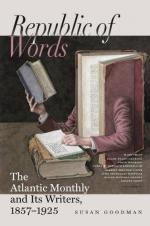I have spoken only of the land-birds; but the position of our city, so embraced by the sea, affords unusual opportunities for observing the sea-birds also. All winter long, from the most crowded thoroughfares of the city, any one, who has leisure enough to raise his eyes over the level of the roofs to the tranquil air above, may see the gulls passing to and fro between the harbor and the flats at the mouth of Charles River. The gulls, and particularly that cosmopolite, the herring gull, are met with in this neighborhood throughout the year, though in summer most of them go farther north to breed. On a still, sunny day in winter, you may see them high in the air over the river, calmly soaring in wide circles, a hundred perhaps at a time, or pluming themselves leisurely on the edge of a hole in the ice. When the wind is violent from the west, they come in over the city from the bay outside, strong-winged and undaunted, breasting the gale, now high, now low, but always working to windward, until they reach the shelter of the inland waters.
In the spring they come in greater numbers, and other species arrive: the great saddle-back, from the similarity of coloring almost to be mistaken for the white-headed eagle, as he sits among the broken ice at the edge of the channel; and the beautiful little Bonaparte’s gull.
The ducks, too, still resort to our rivermouth, in spite of the railroads and the tall chimneys by which their old feeding-grounds are surrounded. As long as the channel is open, you may see the golden-eyes, or “whistlers,” in extended lines, visible only as a row of bright specks, as their white breasts rise and fall on the waves; and farther than you can see them, you may hear the whistle of their wings as they rise. Spring and fall the “black ducks” still come to find the brackish waters which they like, and to fill their crops with the seeds of the eel-grass and the mixed food of the flats. In the late twilight you may sometimes catch sight of a flock speeding in, silent and swift, over the Mill-dam, or hear their sonorous quacking from their feeding-ground.
At least, these things were,—and not long since,—though I cannot answer for a year or two back. The birds long retain the tradition of the old places, and strive to keep their hold upon them; but we are building them out year by year. The memory is still fresh of flocks of teal by the “Green Stores” on the Neck; but the teal and the “Stores” are gone, and perhaps the last black duck has quacked on the river, and the last whistler taken his final flight. Some of us, who are not yet old men, have killed “brown-backs” and “yellow-legs” on the marshes that lie along to the west and south of the city, now cut up by the railroads; and you may yet see from the cars an occasional long-booted individual, whose hopes still live on the tales of the past, stalking through the sedge with “superfluous gun,” or patiently watching his troop of one-legged wooden decoys.




